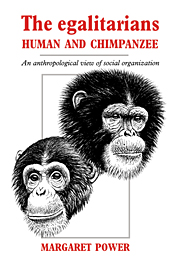Book contents
- Frontmatter
- Contents
- Foreword by A. Montagu
- Acknowledgments
- Part 1 Methods and prefatory explanations
- Part 2 The human foragers
- Part 3 The changing social order
- Part 4 The behavior of wild and provisioned groups: a theoretical analysis
- Part 5 The mutual dependence system
- Part 6 The egalitarian chimpanzees
- Part 7 Probabilities, possibilities and half-heard whispers
- Notes
- References
- Index
Part 7 - Probabilities, possibilities and half-heard whispers
Published online by Cambridge University Press: 18 December 2009
- Frontmatter
- Contents
- Foreword by A. Montagu
- Acknowledgments
- Part 1 Methods and prefatory explanations
- Part 2 The human foragers
- Part 3 The changing social order
- Part 4 The behavior of wild and provisioned groups: a theoretical analysis
- Part 5 The mutual dependence system
- Part 6 The egalitarian chimpanzees
- Part 7 Probabilities, possibilities and half-heard whispers
- Notes
- References
- Index
Summary
Traditionally, the final section of a scientific monograph is the one in which the author goes beyond interpreting the data to speculate on a range of implications that she or he thinks is recognizable in the data. The following proposals start from a basis of evidence and theory, but go beyond into the realm of logical possibility. The reason for doing so is to stimulate further discussion and to suggest possible new approaches for further research.
The adaptive value of aggressive behavior: a possibility
The theme of this study is that a system of mutual dependence involving positive behavior, egalitarianism, individual autonomy, and the noninterference form of mutualism (NIM) is the adapted mode of organization of chimpanzees under normal environmental circumstances. It is also argued that this benign, loosely structured form of social order of chimpanzees can change rapidly to encompass negative, society-destroying behavior and a rigidly structured dominance hierarchy.
It is now known that equal potentials for aggressive or peaceful responses are both part of the genetic constitution of all animals; there is no genetic coding that inevitably results in either aggression or peacefulness, only a set of genetic attributes ultimately for self-defense ‘that can be expressed as aggressiveness under particular sets of conditions’ (Dubos 1973:86). It follows that also part of this set of genetic attributes are those that act to maintain peace, under differing conditions. The ultimate goal of the entire set is survivial of the species.
- Type
- Chapter
- Information
- The Egalitarians - Human and ChimpanzeeAn Anthropological View of Social Organization, pp. 239 - 254Publisher: Cambridge University PressPrint publication year: 1991

